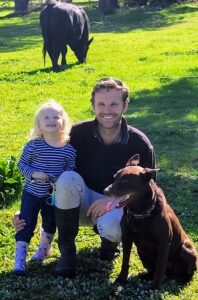Constant learning key to survival as conditions dry
Serpentine-Jarrahdale beef farmer Mark Thomas said back in December he’d had a really bad season.
And that was before he was hit with this especially dry start to autumn, 2024 which has now placed drought response and support for farmers in the headlines and the spotlight.
Looking back, Mark said he probably hadn’t previously taken the risk of poor seasons seriously enough after having a series of consistent years recently. But 2023 had been a reminder to not get complacent.
Mark said at his property, the poor season extended over 12 months, starting with no summer rain in 2022/23, a small late break, a cold winter and then an early finish. It was the early break that would normally set him up.
In his beef paddocks Mark normally cuts 700-800 bales of hay. In 2023 he cut just 200. On his equine paddocks, he cut 220, down from an average of 400. Poor conditions meant he didn’t lock any paddocks up to let them bulk up.
Realising the position he was in, Mark acted quickly and purchased hay to make up his shortfall. He managed to do this while the price was still low.
To get through 2023, Mark accepted he would have a reduced production and didn’t try to maintain levels of output by spending more on supplement. Instead, his cows had to do it a bit tougher and their weaning weights were lower.
In the same situation again, Mark said he would consider supplementing the calves only. His 220 cows would need to get by on what was available resulting in reduced milk production, but suspected supplementing calves from birth could increase their weaning weight.
Grazing Matcher Program insights
It was somewhat timely that, prior to onset of his poor season, Mark completed the Grazer Matcher program.
Supported by South West NRM and Western Beef Association since 2018, the Grazing Matcher program connects livestock enterprises with agricultural advisors over twelve months to increase pasture production, improve fodder conservation and make cost-effective supplementary feed purchases.
Mark said now when he makes a decision, he refers back to the Grazing Matcher learnings and asks if his decision fits. He believes it helped him get through 2023 better than he otherwise would have.
For example, Mark said he previously put cows onto pasture when the season broke. But now he defers grazing for 4-5 weeks in a 15-20 acre low production sacrifice paddock to let the pasture elsewhere establish. The practice is said to increase pasture growth throughout the season. As a result, Mark believed at the end of 2023, he had gotten through the season pretty well.
Other approaches
Mark has tried perennials but says he took short cuts that meant they hadn’t performed well.
He says he didn’t allow them enough time to develop and grazed too heavily given the lack of growth. He also doesn’t believe he got his soil preparation right with insufficient nutrition and low soil pH, as low as 3.9.
Mark said one of his biggest gains had been with software application Rumen8, used for managing beef and dairy cattle diets. He was introduced to Rumen8 through the Grazing Matcher program and now “lives on it”, using it twice a week.
“I have several different types of feed I can use, from dry feed in the paddock, kikuyu in summer, old hay, new hay, silage, and pellets, all with different feed quality and protein,” he said.
“So I use Rumen8 to balance what I am feeding to each class of stock so they get enough nutrition without wasting feed. The training we had in Grazing Matcher helps to understand how to use Rumen8 and some of the numbers behind it.
One of the ways to confirm if feed strategies are adequate is to condition score animals. In the past, if there were lower condition cows in the mob, Mark would set feeding rates to meet their requirements, which meant other cows in the mob received too much feed. Now he separates them from the main mob to limit numbers receiving extra feed so they all get to winter in the same condition.
For more resources and Drought Adaptation case studies, visit this page of our website.
